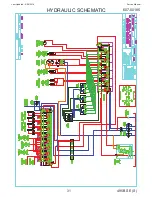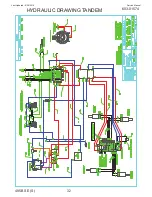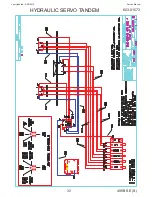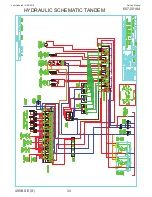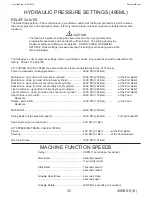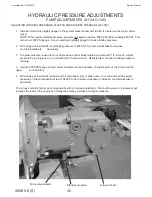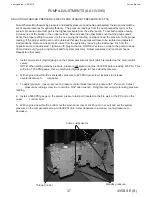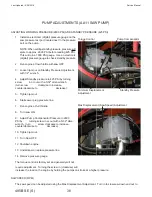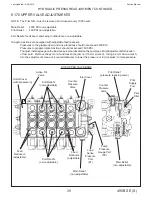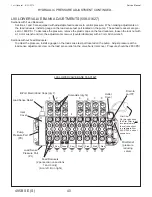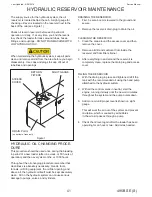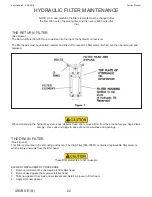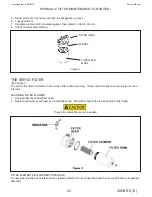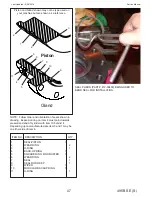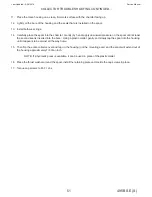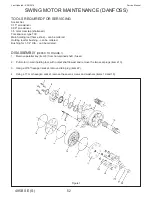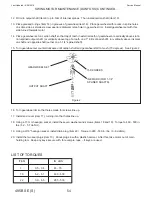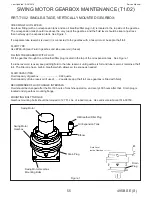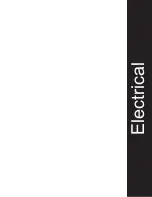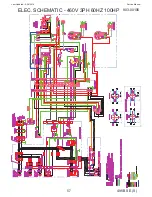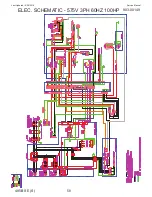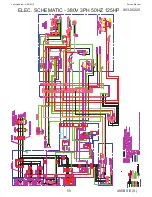
Service Manual
Last Updated - 9/28/2016
495B SE (S)
44
ELIMINATING AIR FROM THE SYSTEM
All hydraulic fluid contains some dissolved air, usually about 10% by volume. Under increased pressure, the fluid will
absorb much more air. Aeration in a hydraulic circuit is the presence of free air in places where there ought to be only
fluid. Usually the air will be in the form of bubbles dispersed through the fluid.
Difficulties with aeration will occur more frequently as flow velocities increase in hydraulic components. This
section covers some of the causes of air being introduced into a system and the suggested practices to effectively
reduce and eliminate this problem.
CAUSES
The most common places for air to be introduced into a hydraulic system or for aeration to occur are listed below:
1. Damaged inlet line; loose or defective fittings or seals at any component.
2. Damaged return line; loose or defective fittings or seals at any component.
3. Damaged or worn cylinder rod, packing or seals.
4. Cracked junction blocks, tees or piping.
NOTE: Because fluid acts as a sealant at atmospheric pressure, when system drops below atmospheric pressure air
may be drawn in where fluid will not necessarily leak out.
5. Fluid level too low. This can cause vortexing at pump inlet in reservoir, thus drawing in air.
6. Air trapped in filter with no means of bleed off.
7. Return fluid discharged above fluid level in reservoir. Poor baffling in the reservoir can also cause turbulence and
resultant introduction of air.
8. Air trapped in system during original filling, or when adding fluid for makeup.
DAMAGE TO THE SYSTEM
The condition listed in the previous paragraph all contribute to inducing air into a hydraulic system. This aeration can
cause jerky and uneven movement in pumps and motors, seizure, overheating, and possibly eventual failure.
HOW TO AVOID AERATION
Regular inspection and regular maintenance are the best ways to prevent air from being introduced into a hydraulic
system. Keeping all connections and fittings tight is the easiest way to avoid the introduction of air.
Return fluid entering the reservoir will create aeration if it is discharged above the main body of the fluid in the tank.
To prevent this condition, maintain sufficient fluid in the tank to keep the return line submerged. The pump intake line
should always be below the fluid surface for the same reason.
Improved service life depends on maintaining proper conditions within the system.
Summary of Contents for 495B - SE
Page 3: ...Introduction...
Page 15: ...Maintenance...
Page 18: ...Service Manual Last Updated 9 28 2016 495B SE S 18 SERVICE SCHEDULE...
Page 19: ...Service Manual 495B SE S 19 Last Updated 9 28 2016 SERVICE SCHEDULE CONTINUED...
Page 20: ...Service Manual Last Updated 9 28 2016 495B SE S 20 SERVICE SCHEDULE CONTINUED...
Page 21: ...Service Manual 495B SE S 21 Last Updated 9 28 2016 SERVICE SCHEDULE CONTINUED...
Page 22: ...Service Manual Last Updated 9 28 2016 495B SE S 22 SERVICE SCHEDULE CONTINUED...
Page 28: ...Hydraulic...
Page 29: ...Service Manual 495B SE S 29 Last Updated 9 28 2016 HYDRAULIC DRAWING 603 01594...
Page 30: ...Service Manual Last Updated 9 28 2016 495B SE S 30 HYDRAULIC SERVO DRAWING 603 01593...
Page 31: ...Service Manual 495B SE S 31 Last Updated 9 28 2016 HYDRAULIC SCHEMATIC 607 00185...
Page 32: ...Service Manual Last Updated 9 28 2016 495B SE S 32 HYDRAULIC DRAWING TANDEM 603 01574...
Page 33: ...Service Manual 495B SE S 33 Last Updated 9 28 2016 HYDRAULIC SERVO TANDEM 603 01573...
Page 34: ...Service Manual Last Updated 9 28 2016 495B SE S 34 HYDRAULIC SCHEMATIC TANDEM 607 00184...
Page 56: ...Electrical...
Page 71: ...Service Manual 495B SE S 71 Last Updated 9 28 2016 AIR CONDITIONER MAINTENANCE CONTINUED...
Page 72: ...Service Manual Last Updated 9 28 2016 495B SE S 72 AIR CONDITIONER MAINTENANCE CONTINUED...
Page 73: ...Service Manual 495B SE S 73 Last Updated 9 28 2016 AIR CONDITIONER MAINTENANCE CONTINUED...
Page 74: ...Service Manual Last Updated 9 28 2016 495B SE S 74 AIR CONDITIONER MAINTENANCE CONTINUED...
Page 78: ...Maintenance...
Page 88: ...Structural...
Page 93: ...Trouble Shooting...


